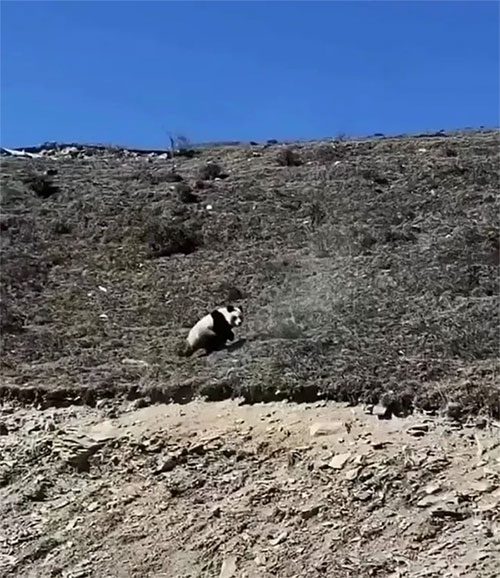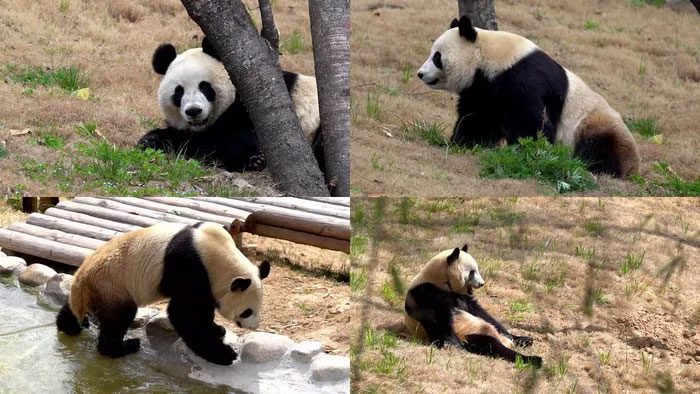The giant panda is a bear species native to China. It is easily recognized by its large black patches around the eyes, on the ears, and on its limbs.
Recently, a short video titled “Wild giant panda found in the Qinghai Plateau” appeared on the Internet. The location in the video seems to be a relatively desolate area, covered with yellow sand and rocks. After the video was posted, it quickly sparked discussions among netizens, many of whom argued that it is impossible for wild giant pandas to appear in Qinghai because they could not survive there.
Qi Xinzhang, Deputy Director of the Qinghai Wildlife Breeding and Rescue Center in China, mentioned: “Qinghai is located in the northeastern part of the Qinghai-Tibet Plateau. There is no bamboo here. Giant pandas would starve if they came here. The climate is cold and dry, so there is nowhere for giant pandas to survive“.

Giant pandas cannot exist in the Qinghai Plateau.
Giant pandas thrive in humid environments and prefer humidity levels around 80%. However, the climate in Qinghai is very dry, making it completely unsuitable for giant pandas to survive, so it is highly likely that the aforementioned video is fake, designed to attract attention and generate traffic.
Current Status of Giant Pandas
Giant pandas are considered a national treasure of China, adored by people worldwide for their cute appearance and innocent behavior.
Most people associate giant pandas with Sichuan, China, but in reality, there are two subspecies of giant pandas: the Sichuan subspecies and the Qinling subspecies.
In addition to Sichuan, there is also a type of giant panda that lives in the Qinling Mountains. Compared to the Sichuan subspecies, Qinling giant pandas are larger in size, but their heads are smaller than those of their Sichuan counterparts. In terms of appearance, the Sichuan subspecies is cuter, which is why the general image of adorable giant pandas is mostly associated with Sichuan giant pandas.

Giant pandas are considered a national treasure of China.
The distribution range of giant pandas is very narrow, and most wild individuals live in Sichuan. According to the fourth population survey of giant pandas published by the Sichuan Forestry and Grassland Administration, the giant panda population in Sichuan is 1,206 individuals, accounting for 76% of China’s total giant panda population.
Although Sichuan has the largest distribution of wild giant pandas, there is not much suitable habitat; in theory, there is only about 30,000 square kilometers. In reality, aside from rivers, roads, and high mountains, areas without bamboo are inaccessible for pandas, so the actual habitat for giant pandas occupies only about 20% of the total area mentioned. The habitat of this species is severely fragmented, and no part of it exists in Qinghai province.

Giant pandas are actually very lazy animals.
Living Habits of Giant Pandas
Many may think that most animal species have migratory habits, such as wildebeests on the African plains, which live off water and grass; or snow leopards in snowy plateaus that move to lower forests in winter.
However, most of these animals have high mobility and distinct exploratory behaviors. For example, a Bengal tiger in India can travel thousands of kilometers from Tipishwar Wildlife Sanctuary to Danyang Nanga Wildlife Sanctuary.
Yet, giant pandas are actually very lazy animals, often dubbed the “hermits of the bamboo forest.” Throughout their evolution, giant pandas have nearly abandoned meat, with bamboo making up 99% of their diet.
Bamboo is a food source that has a much lower caloric absorption rate for pandas compared to meat. This has forced giant pandas to eat a vast amount of food to maintain the energy necessary for survival, which is why they spend a significant amount of time eating each day.
At the same time, they minimize unnecessary activities, resulting in giant pandas becoming very inactive; they eat, sleep, or play every day, and their activity range is very limited.
The Shaliu River in Qinghai is far from Sichuan, Shaanxi, and Gannan, making the idea of wild giant pandas wandering there simply unrealistic.

Giant pandas spend a lot of time eating each day.
No Giant Pandas in Qinghai Since Ancient Times
Not to mention that today there are no giant pandas in Qinghai, even fossil data excavated shows that historically, there were no giant pandas in Qinghai. Giant pandas are often referred to as “living fossils” of the animal kingdom, having existed on Earth for about 8 million years.
The oldest known ancestor of the giant panda was a small animal that evolved from a bear-like species at the end of the Miocene epoch.
The appearance of the first panda was very different from that of modern giant pandas, and its body was only comparable to that of a fat fox. The early pandas were carnivorous, primarily feeding on small animals that existed at that time.

Fossil data also shows that there were no giant pandas in Qinghai historically.
The evolutionary process of giant pandas has roughly gone through four stages: the stage of the first panda, the stage of the small giant panda, the stage of the Papian giant panda, and the stage of the modern giant panda.
At the beginning of the Pleistocene epoch, the small giant panda evolved, and by this time, they had shifted to relying on bamboo as their primary food source. These small giant pandas had an appearance similar to that of modern giant pandas but were smaller in size.
During the middle and late Pleistocene, the Papian giant panda appeared, with a body size about 12% larger than modern giant pandas; this was also the period when giant pandas reached their peak.
Throughout the Pleistocene epoch, the habitat of giant pandas was widely distributed, covering most of eastern and southern China, and even extending into Myanmar and Vietnam at one time. Although giant pandas were at their peak, their distribution did not reach Qinghai province.
Many believe that the evolution process of giant pandas to the stage of modern giant pandas marks the end of the species’ evolutionary journey; without crucial human protection, they might have disappeared from the Earth.
Regardless of the ancient and modern distribution perspective or their habits and feeding behavior, we can still assert that wild giant pandas cannot exist in the Qinghai Plateau.


















































